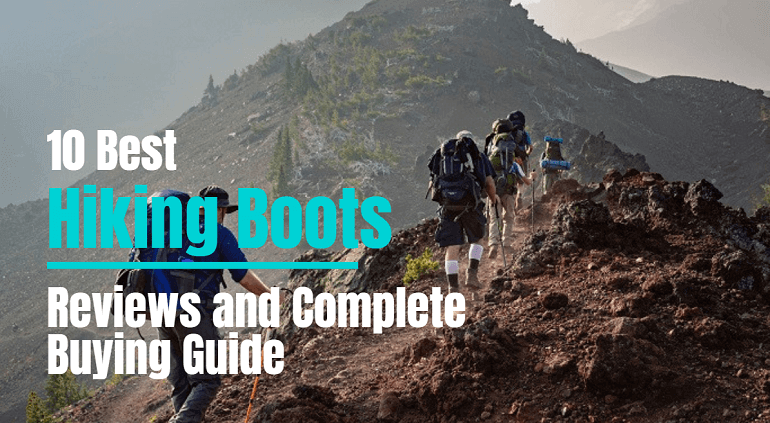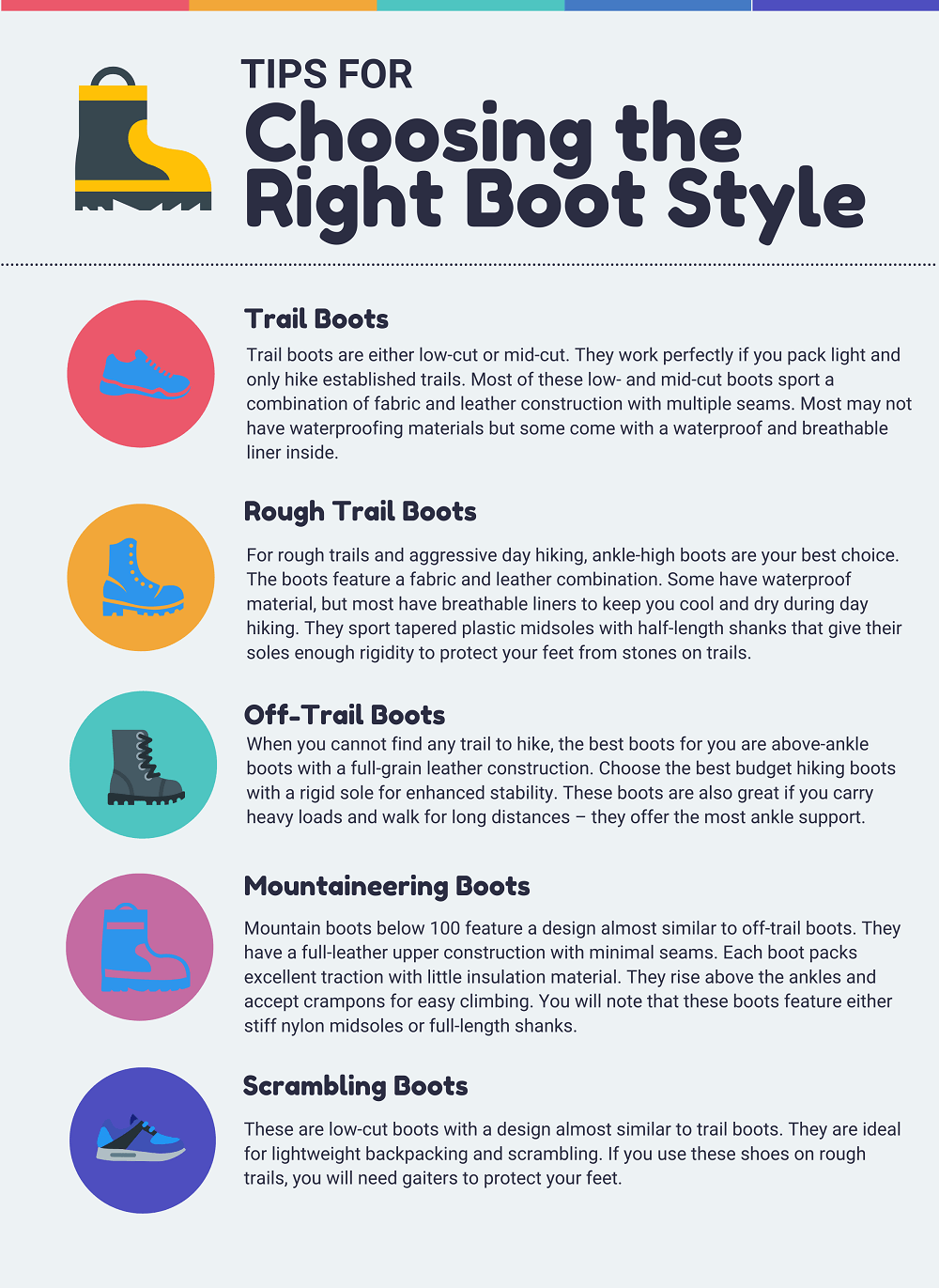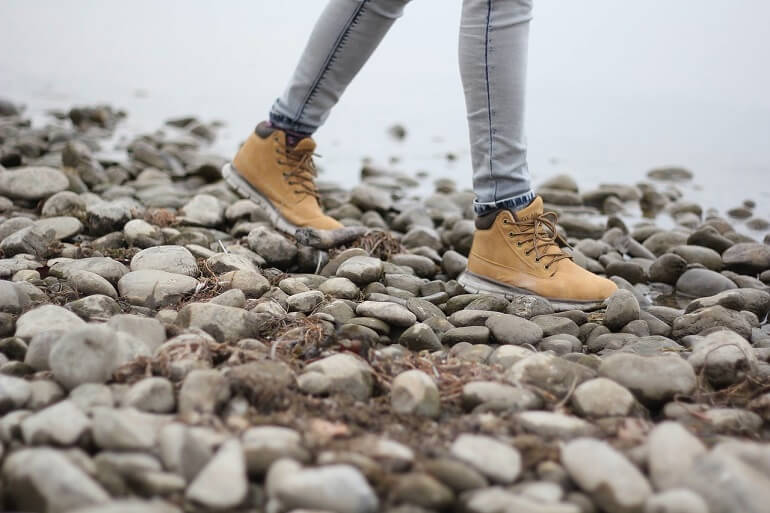
Hiking is a great way to keep fit, experience nature, and clear your mind from long days at the office. However, hiking with the wrong boots will lead to the development of blisters, make your feet swell, and cause so much pain.
A good pair of hiking boots protect your feet and your ankles and makes it comfortable for you to walk for long distances. The boot also keeps your feet dry and gives you a better grip when you walk on slippery terrain.
With hundreds of brands of hiking boots on the market, it is challenging to choose the right pair. In this guide, I considered the following factors in picking the best hiking boots under 100:
The right boot for you is not necessarily right for another person. When shopping, factors such as where you will be hiking, your feet size and shape, and the prevailing weather at the time of your hike determine the right boot for you. To know which boot fits your hike and your feet succinctly, here is a quick view.
Columbia Newton Ridge Plus Women’s Hiking Boot
Keen Targhee II Men’s Waterproof Hiking Boots
Clorts Women’s Leather Boot
Merrell Moab Ventilator Men’s Hiking Boots
Columbia Newton Ridge Plus II Men’s Hiking Boots
Hi-Tec Women’s Skamania Hiking Boot
Danner Radical 452 GTX Men’s Boot
Ahnu Alamere Women Hiking Boot
Merrell Women’s Moab II Hiking Shoe
A good boot should not only fit you comfortably, but also match the terrain you will be hiking and the load you might carry during the hike. Any ounce of load you add takes your energy and that might make you feel fatigued at the end of the day. Ergo, only go for the lightest boots. For instance, if you only follow trails and hike short distances, a pair of off-trail boots might be an overkill. Based on styles and hiking terrain, there are five types of boots:

The hiking boot materials and design determine its comfort and durability. Some materials are more suited for some terrains than others as I discussed above.
The Hiking Boot Upper Materials and their Impact on Boot Comfort
A good midsole provides cushioning and protects your feet from shock, especially when you carry a large backpack. The midsole determines how stiff the boot feels. A flexible boot might sound like the ideal boot, but if you plan to go on long hikes on rocky terrain, a stiff midsole offers you the support, stability, and comfort you need.
When the boot is stiff, it doesn’t wrap around every uneven ground you step on and this means that your foot will not feel fatigued. Midsoles feature either EVA (ethylene vinyl acetate) or polyurethane materials.
EVA feels more comfortable, lighter, and costs relatively less. Hiking boot manufacturers create boots with varying levels of densities to provide support where needed, such as around the forefoot. Polyurethane is firm, stiffer, and more durable. The best budget walking boots for mountaineering and long hikes feature polyurethane.
The internal support in a hiking boot determines how comfortable the boot feels when you carry a heavy backpack. Support comes in the form of shanks or plates.
Shanks are inserted between the midsole and the outsole. The 3-5mm inserts give your boots load-bearing stiffness so you can hike for long distances with a heavy load. Shanks either cover the full-length or half of the boot’s midsole.
Plates are inserts under shanks. They are thinner thank shanks and semiflexible and they protect your feet from bruises caused by roots and uneven rocks.

The main material used on hiking boots outsole is rubber. However, mountaineering and backpacking boots might have other additives (mostly carbon), to harden the rubber for durability. Hard outsoles are great if durability is your concern, but they offer less traction.
Lug patterns on the outsole determine how much traction the best hiking boots under 100 provide. Deeper and thicker lugs provide more grip for mountain climbing and backpacking. Widely spaced lugs release mud with ease if you walk during muddy days.
Heel brake is another outsole feature which refers to a distinct heel zone away from the forefoot and the arch. This part ensures you do not slip when descending steep terrain.
Boots used for mountain climbing and winter hiking need compatibility with crampons. Most of these boots feature a lip on the outsole’s welt from where you attach the crampon.
The foot anatomy of a man varies from that of a woman. Not only is the female foot smaller, but it also comes in different shapes. Granted, even if a man and a woman wear the same boot size, it is still vital that each picks a shoe designed for their gender. Below are a few differences in the anatomy:
Given the differences above, most hiking boot manufacturers design boots for males and females separately.
The best hiking boots under 100 should fit snugly – they should not be too tight or too loose. When worn, the shoes should give you room to wiggle your toes. When shopping, therefore, you need to know your foot length, arch length, and foot width. Once you have your foot size, check the sizing charts that come with your favorite boot to choose the length. Some factors that impact the fit and comfort of a hiking boot include:
If you have feet conditions, such as flat feet, you need to look for special hiking boots designed with the right support to protect your feet further. For instance, someone with flat feet requires more arch support and someone with planar fasciitis requires more heel and forefoot support. These special boots protect your feet from further damages on the tendons and keep you comfortable during the hike.

| Title | Men/Women | Upper Material | Outsole Material | Style |
|---|---|---|---|---|
| Timberland White Ledge Men’s Hiking Boot | Men | Men Full-grain leather | Rubber | Mid-cut |
| Columbia Newton Ridge Plus Women’s Hiking Boot | Women | Nubuck leather, suede, mesh fabric | Rubber | Mid-cut |
| Keen Targhee II Men’s Waterproof Hiking Boots | Men | Nubuck leather | Rubber | Mid-cut |
| Clorts Women’s Leather Boot | Women | Suede leather. Mesh fabric | Rubber | Mid-cut |
| Merrell Moab Ventilator Men’s Hiking Boots | Men | Synthetic leather, mesh fabric | Synthetic vibram sole | Mid-cut |
| Columbia Newton Ridge Plus II Men’s Hiking Boots | Men | Full-grain leather, suede, mesh fabric | Rubber | Mid-cut |
| Hi-Tec Women’s Skamania Hiking Boot | Women | Suede, mesh fabric | Rubber | Mid-cut |
| Danner Radical 452 GTX Men’s Boot | Men | Nubuck leather, nylon | Rubber | Mid-cut |
| Ahnu Alamere Women Hiking Boot | Women | Nubuck leather, mesh fabric, and synthetic material | Rubber | Mid-cut |
| Merrell Women’s Moab II Hiking Shoe | Women | Suede leather, mesh fabric | Vibram sole | Low-cut |
Being made of full-grain leather, the White Ledge is waterproof to keep your feet dry and warm in wet weather. Its full-leather construction does not affect its comfort, thanks to the padded collar and tongue for additional comfort and ankle support.
The footbed sports an EVA foam construction that enhances the breathability and comfort of the boot. This removable footbed allows air to circulate through its perforations to wick away moisture and keep you cool and dry. Granted, you can use the boot for summer hikes. To facilitate walking on slippery grounds, the shoe features an advanced traction system, the BSFP Traction (Brake, Support, Flex, and Propel System). Better yet, the outsole has a rugged design to facilitate further walking on slippery grounds.
Its gusseted tongue ensures there is less pressure from boot laces and to keep debris off your feet.
Pros
Cons
The Newton Ridge Plus Women hiking boot sports a classic mountaineering style. The combination of materials makes this shoe comfortable, breathable, and ideal for use in wet conditions. The seams are water-sealed but the materials are highly breathable to keep your feet warm and dry. Inside the boot is a comfortable Techlite midsole that is not only lightweight, but also provides superior comfort and support.
Columbia uses its patented Omni-Grip rubber that provides high grip when you walk on slippery terrain – this makes the boot a three-season use shoe. Further, the boot features a multi-zone tread pattern that facilitates solid footing on wet stones.
Its waterproof coating also makes it stain-resistant to keep your boots looking new for a long time.
Pros
Cons
The Nubuck leather construction makes this mid-cut boot lightweight. You can wear it on extended hikes and for mountaineering without feet fatigue. It sports a leather and fabric combination that makes it sturdy but flexible. The fabric material on the upper boot makes it more breathable for use for a summer hike. Better yet, the boot features a breathable leather lining that allows the circulation of air in and out of the boot. Whether you sweat or hike in wet conditions, your feet stay cool and dry at all times.
The rubber outsoles sport a contoured shape that offers more traction when you walk on rocky or slippery surfaces. Its 4mm lugs and the heel lock enhance the grip of the boots to lessen the chances of slipping. The manufacturer adds padding to the tongue and collar to enhance comfort and reduce the chance of developing blisters.
Pros
Cons
Made of suede and mesh upper, this boot combines durability, waterproofness, and breathability. The boots are ideal for walking on muddy or rocky terrain.
Clorts uses Uneebtex breathable and waterproof membrane to enhance the comfort of your shoe. This way, you can walk in puddles or water during your hike without the fear that your feet will get wet. The manufacturer further uses its innovative Hike Technology that adds support in all the right places to protect your feet when you carry a heavy backpack.
The shank coupled with the EVA footbed and padded collar and tongue keep the shoe comfortable for extended hikes. In 2019, Clorts updated the sizing of the shoes to offer a snug fit for all sizes. Therefore, do not size up or down.
Pros
Cons
Although the Merrell Moab sports a synthetic construction, the boot is highly durable, breathable, and comfortable. The synthetic Vibram leather coupled with the mesh fabric is well ventilated to allow air in and out of the boot. This makes this mid-cut boot ideal for use in summer weather.
The manufacturer incorporates its innovative FRESH system, which prevents the formation of odors. This way, you do not use powders or deodorant inserts. Inside the shoe is a four-inch shaft that protects your arch from damage when you carry a heavy load. On the heel is an air cushion that absorbs shock when you walk on rocky terrain carrying a heavy load. Better yet, the boot also features an Ortholite system that makes the footbed more comfortable and provides extra support for extended hikes.
Pros
Cons
The Ridge Plus II sports a combination of three materials for a great balance between support, comfort, breathability, and waterproofness. At the highest section is a leather material that rises five inches from the arch for maximum ankle and foot support.
Each of the materials features a waterproof coating that makes the boot water-resistant. This coating does not affect the breathability of the shoe as you can still wear it for summer hiking. It further features a tongue and collar padding that enhances the comfort of the boot.
Inside the boot is a Techlite patented midsole that makes the shoe highly supportive for extended hikes. The midsole features lightweight materials to prevent fatigue after a hike. Furthermore, the rubber outsole comes with Omni-Grip traction rubber that ensures you do not slip even when you walk on slippery terrain.
Pros
Cons
The Hi-Tec Skamania comes in a durable design that allows you to use it in extended hikes. The suede and leather construction makes the shoe flexible while enhancing its breathability. Hi-Tec adds Dri-Tec waterproof membrane that allows you to use the shoe in small puddles of water without your feet getting wet.
Inside the boot is a molded EVA footbed that absorbs shock and offers enough support and comfort. The rubber soles on the boot sport deep lugs for enhanced traction. You can, therefore, use this boot on slippery terrain or for mountaineering.
It is only available in three neutral colors –which do not show dirt. Further, its waterproof membrane makes it relatively stain resistant to maintain its original look. It cleans with ease and dries within a few hours.
Pros
Cons
The combination of Nubuck leather and nylon fabric enhances the ventilation of the boot for added comfort. The manufacturer further adds a breathable lining to wick away sweat and keep you dry at all times. Each of the two materials is highly durable, making the shoe abrasion resistant for use in rough terrains. With the protective toe cap, the boot holds up well for a long time.
This is a lightweight boot for use in moderately challenging long hikes. It sports a Gore-Tex waterproof material that allows you to walk in wet conditions. Its thermoplastic shank further makes it resistant to moisture. Danner uses the Terra Force platform, which makes the shoe stable on rough terrain and further makes the shoe lightweight.
Pros
Cons
The Ahnu Alamere features 40 percent Nubuck leather, 34 percent hydrophobic ripstop fabric, and 26 percent synthetic material. The leather makes the boot rugged and durable, the mesh enhances the boot’s durability and makes it lightweight, while the synthetic makes the shoe waterproof.
The shoe comes with a spider rubber outsole that delivers enough traction to keep you stable on slippery grounds. Its dual-density EVA midsole offers the right balance between comfort and support. This midsole also absorbs shock when you walk on rocky terrain.
Ahnu uses a high-quality shank that makes the shoe rigid and supportive regardless of the terrain.
Pros
Cons
The Merrell Moab II is a low-cut women’s hiking boots that delivers great comfort and support when you are hiking. The shoe features M Select dry, which wicks away moisture to keep you dry at all times. Each shoe comes in high-performance Vibram rubber sole with deep lugs for advanced traction.
Merrell uses air cushion in its heel to improve comfort by reducing stress on your feet during extended hikes. This might be a great choice if you are looking for a vegan and sustainable shoe – the construction materials are recycled, making the shoe safe for the environment.
The low-cut boot sports enough ventilation for air circulation in and out of the shoe. It also features padding in all friction areas for comfort.
Pros
Cons
Snow presents two challenges, it is slippery and wet. Granted, you need hiking boots that are waterproof (preferably 100-percent waterproof) and slip-resistant. Although you will walk comfortably with some of the boots on my list, I recommend that you buy snow boots as they are more adapted to snow conditions. Even with padding, a hiking boot may still not offer enough protection against cold.
Hiking shoes are great for hiking on established trails for short distances. They may not be rugged enough to venture off-trail and they do not protect your ankle as hiking boots do. If you want to use your running shoes before you buy hiking shoes, choose shoes with enough arch support. Even then, the sole of the shoe will eventually compress. To avoid stress, only go for hiking boots that have enough feet and ankle support.
There is no difference between the two – differences in hiking shoes come in style (low, mid, or high cut). High cut boots are the most ideal when you need advanced ankle protection, such as when you hike a steep terrain. Low cut boots are what most hikers call hiking shoes. These are ideal when you hike established trails for a short distance. However, they expose your ankles.
The way you tie the laces of your boot determines how comfortable you feel and the safety the boot offers. Loose laces keep you stopping to tie them while improper lacing makes the shoe crooked. If you tie the boots too tight or too loose, you might end up with blisters and bruises.
Shop for boots whose lacing system ends up at the top end of the boot. This way, you can adjust the lacing as you desire to make the boot comfortable. Tie the shoe to the last hole or hook to ensure that no gaps remain at the top collar for a snug fit during the hike. Make the lacing comfortable since too tight or too loose lacing might affect your stability. You can watch the video bellow for more details.
Leather boots take a few weeks to break in. During this time, the boots might cause blisters and bruises, especially if they have thin or no padding. One way to reduce blisters and bruises is to ensure you buy the right size. If the shoe size runs small or large, it will likely cause blisters and feel very uncomfortable. Second, you can use leather conditioner or oil, which helps soften the boots without causing any damage. Apply the oil weekly until the boots are soft and then monthly to care for your boots.
Before the hike, you need to wear the shoes around the house with thick socks so make them soft. When you wear thick socks, you stretch the leather a bit, making it comfortable the next time you go hiking. If the boots still remain stiff even after wearing for a few weeks, consider using a boot stretcher to expand them for comfortable use. Avoid immersing your boots in water as this might make them shrink. Again, avoid exposing them to heat to break-in as heat will damage the leather.
The method you employ to clean your hiking boots depends on the upper material. Leather boots only require wiping as dipping them in water might shrink them. Your leather should also not be exposed to a lot of sun when drying and so wiping is the way to clean them. Luckily, leather boots seldom catch stains. Synthetic materials are easy to clean as you can dip the shoe in water and it dries within an hour.

The Timberland White Ledge Men’s Hiking Boot is my favorite among the best hiking boots for men under $100. It is a rugged hiking boot that offers enough support and comfort for all forms of hunting.
If you need the best hiking boots under 100 for women, the Columbia Newton Ridge Plus Women’s Hiking Boot delivers in all hiking conditions. It is tough and offers enough feet and ankle support.
These two boots are mid-cut style which makes them highly versatile. They are also waterproof and breathable. Click on the products to check them out.
© 2021 by OutdoorStuffGudies.com
OutdoorStuffGudies.com is a participant in the Amazon Services LLC Associates Program, an affiliate advertising program designed to provide a means for sites to earn advertising fees by advertising and linking to Amazon.com.